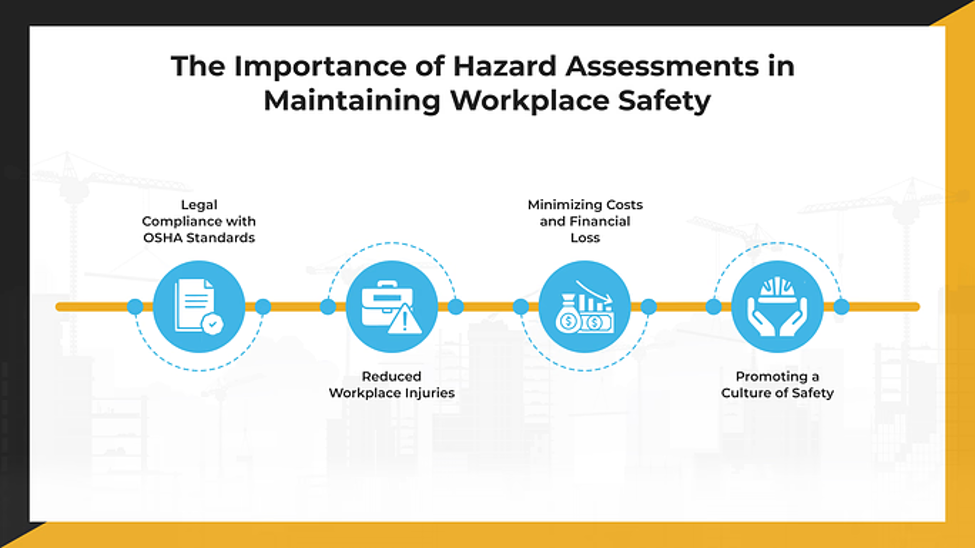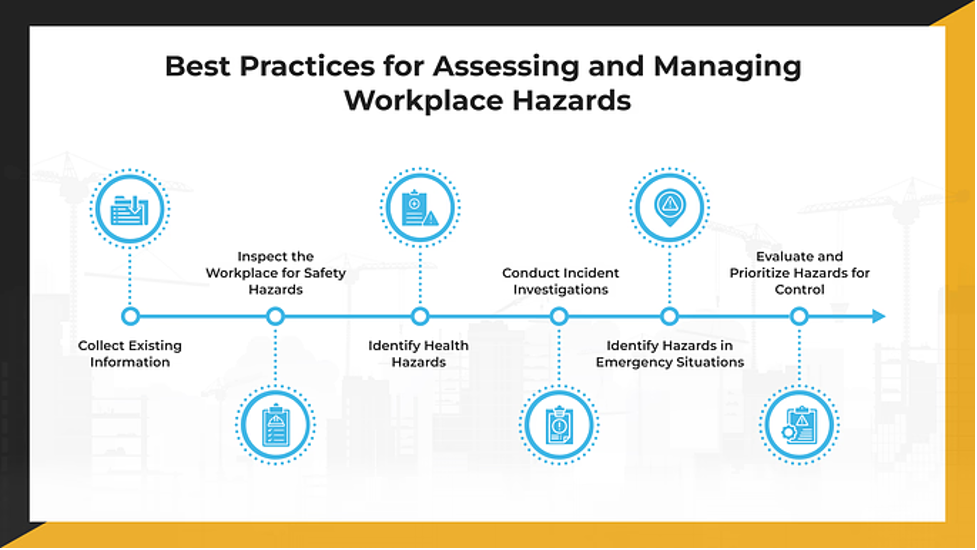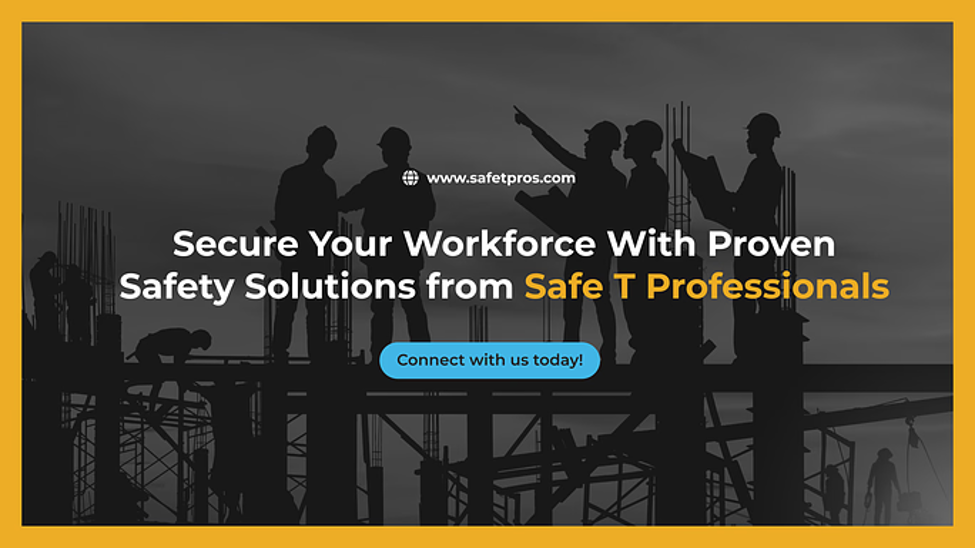Many organizations invest in safety programs, training sessions, and compliance checklists—yet overlook the foundation of it all: a strong, consistent hazard assessment process. According to OSHA, employers must evaluate the workplace for hazards that require protective measures. But in practice, this often becomes a one-time task rather than a living process.
The problem is widespread. OSHA issues thousands of citations yearly for failing to assess and control workplace hazards properly.
In 2023 alone, improper hazard assessments were a key factor in over 25% of the top 10 most frequently cited OSHA standards. Meanwhile, data from the Bureau of Labor Statistics (BLS) shows that over 2.6 million nonfatal workplace injuries and illnesses were reported by private industry employers in the U.S. in the same year. Many of these incidents could have been prevented through more effective hazard identification and control.
The costs of neglecting hazard assessments extend beyond injuries, leading to lost productivity, higher insurance premiums, fines, and potential reputational damage. Most importantly, it erodes trust in a company’s safety culture, which is challenging to rebuild.
If you are responsible for health and safety, managing risk in a manufacturing facility, overseeing field operations, or reviewing processes in an office environment, this blog will walk you through the steps to build a proactive, OSHA-aligned hazard assessment process.
Understanding Hazard Assessments: Definition, Scope, and Practical Examples
A hazard assessment is a process that identifies potential hazards in the workplace that could cause injury or illness. According to OSHA’s standard 29 CFR 1910.132(d), employers must:
| Assess the workplace to determine if hazards are present or are likely to be present that necessitate the use of personal protective equipment (PPE). |
This assessment is a formal, documented review of the work environment, equipment, tasks, and practices to find anything that could harm employees. The goal is to identify risks early and control them before they cause an incident.
Hazard assessments cover a wide range of workplace risks. These include:
| Type of Hazard | Description |
| Physical Hazards | These include things like moving machinery, and tools, slippery floors, excessive noise, heat, or exposure to electricity. |
| Chemical Hazards | Exposure to harmful substances such as cleaning agents, solvents, fumes, or gases. This includes risks from spills, leaks, or improper storage. |
| Biological hazards | Viruses, bacteria, mold, or other organisms can cause illness, especially in healthcare settings, laboratories, and food processing facilities. |
| Ergonomic Hazards | These involve poor workstation setups, repetitive motions, awkward postures, or heavy lifting that can lead to musculoskeletal injuries.
|
| Psychosocial Hazards | Stress, harassment, or overwork can negatively impact mental health. While often overlooked, these are important to assess. |
For example, in a warehouse with forklifts, a hazard assessment would identify several potential risks, including vehicle collisions, struck-by incidents, elevated noise levels, and poorly lit aisles. Based on this, controls like high-visibility clothing, traffic management plans, and training may be recommended. In a chemical plant, the assessment would focus on risks such as chemical burns, inhalation of fumes, spills, or explosions. It might result in the need for ventilation systems, chemical-resistant gloves, and emergency eyewash stations.
The Importance of Hazard Assessments in Maintaining Workplace Safety
Here is why hazard assessment is necessary for your workplace:
Legal Compliance with OSHA Standards
Hazard assessments are a legal requirement under OSHA regulations. Employers must evaluate the workplace to identify potential hazards that could harm employees and determine whether personal protective equipment (PPE) is needed. Failure to comply with this requirement, outlined in 29 CFR 1910.132(d), can result in citations, penalties, or legal action.
OSHA inspections may focus on whether the employer has properly assessed and documented workplace hazards. Non-compliance can lead to fines, which vary depending on the severity and frequency of violations.
Reduced Workplace Injuries
Hazard assessments are one of the most effective ways to reduce workplace injuries and illnesses. By systematically identifying and addressing risks before they lead to incidents, organizations can significantly reduce their injury rates.
According to data from the U.S. Bureau of Labor Statistics (BLS), workplaces that actively manage safety risks through regular assessments tend to have fewer recordable injuries. This helps prevent accidents, ranging from minor cuts and strains to more serious incidents, such as chemical exposures or machinery-related injuries.
Minimizing Costs and Financial Loss
Unaddressed hazards can lead to high costs, including medical expenses, workers’ compensation claims, legal fees, and operational downtime. By conducting thorough hazard assessments, companies can prevent these expenses by managing risks early.
Investing in preventive measures, such as safety equipment, training, or process changes, is typically far less expensive than dealing with the aftermath of an injury. In addition, avoiding incidents helps maintain productivity and reduces the risk of production delays or labor shortages.
Promoting a Culture of Safety
Regular hazard assessments signal to employees that safety is a priority. When workers see that the organization is actively identifying and addressing risks, it builds trust and encourages them to take safety seriously.
This helps create a workplace culture where people are more likely to report hazards, follow procedures, and support each other in staying safe. A strong safety culture also contributes to higher morale, lower turnover, and better overall performance.
OSHA’s Requirements for Hazard Assessments
Regulatory Basis
Under OSHA’s standard 29 CFR 1910.132(d)(1), all employers are required to assess the workplace to determine whether hazards exist or are likely to exist that require the use of personal protective equipment (PPE).
Documentation Requirements
Once a hazard assessment is completed, OSHA requires the employer to produce a written certification. This document must include the following specific information:
- The Workplace Evaluated: The document must clearly state the location or area where the assessment was conducted. This helps ensure that the findings are specific and applicable to the actual environment where the work is done.
- The Person Certifying the Assessment: The name or signature of the individual who conducted or is responsible for certifying the assessment must be included. This establishes accountability and confirms that a qualified person performed the evaluation.
- The Date of the Assessment
The certification must also include the date the hazard assessment was completed. This is important for tracking when the evaluation occurred and determining when a reassessment may be due.
Reassessment Triggers
A hazard assessment is not a one-time task. OSHA expects employers to reassess hazards whenever there is a significant change in the workplace. These changes may include:
- New Equipment or Machinery: Introducing new tools or machines may create new risks that were not covered in the original assessment.
- Changes in Work Processes: Modifying how tasks are performed, such as switching to a new chemical or changing production steps, can introduce new hazards.
- Workplace Incidents or Near Misses: Any accident or close call should prompt a review of the existing assessment to determine if anything was missed or has changed.
- Regulatory Updates or Industry Standards: If OSHA issues new guidance or if industry best practices evolve, employers may need to revise their assessments accordingly.
Best Practices for Assessing and Managing Workplace Hazards
Below is a structured outline of key practices for effectively conducting and improving hazard assessments in the workplace.
1. Collect Existing Information
Review all available internal and external data sources to identify known hazards.
Gather operating manuals, Safety Data Sheets (SDS), self-inspection records, and previous incident reports. Analyze OSHA 300 and 301 logs, workers’ compensation claims, and near-miss reports. Review industrial hygiene assessments and medical surveillance records, ensuring appropriate privacy safeguards are in place.
Consult outside sources, such as OSHA, NIOSH, CDC, trade associations, or unions, for updated hazard alerts and best practices. Involve workers by collecting feedback through surveys, safety meeting minutes, or job safety analyses.
2. Inspect the Workplace for Safety Hazards
Conduct regular physical inspections to identify both obvious and hidden risks in the environment. Inspect all work areas, including offices, warehouses, maintenance areas, and storage zones. Observe operations, equipment use, and housekeeping practices.
Document hazards using photos or video. Maintain inspection checklists and records. Involve employees during inspections to gather firsthand input and improve coverage. Pay special attention to plant vehicles and transportation fleets. Evaluate work conditions before introducing new equipment or processes.
3. Identify Health Hazards
Assess potential exposures to chemical, biological, physical, and ergonomic hazards that may not be immediately visible. Review the SDS to identify harmful chemicals, especially those used in large quantities or enclosed areas. Monitor for physical hazards like high noise levels, radiation, and heat exposure.
Assess risks of biological agents such as viruses, mold, or animal-derived materials. Evaluate repetitive tasks, heavy lifting, and vibration sources for ergonomic issues. Conduct exposure assessments using air sampling or other direct-reading instruments. Analyze redacted medical records for patterns linked to workplace conditions.
4. Conduct Incident Investigations
Use incidents, near misses, and employee reports to identify underlying hazards and improve safety measures. Develop a structured process for investigations, assigning roles and materials in advance. Train a team that includes both management and worker representatives. Investigate not only actual injuries but also near misses.
Focus on identifying root causes, not just surface-level errors. Ask detailed questions to uncover failures in systems, training, or supervision. Share findings and corrective actions with all relevant personnel.
5. Identify Hazards in Emergency Situations
Assess risks associated with rare or irregular events, including maintenance work and emergencies. Identify possible emergency scenarios such as chemical spills, fires, extreme weather, or violence.
Review startup and shutdown processes, as well as non-routine maintenance activities. Consider the unique risks in each scenario, based on the materials used and the facility layout. Develop plans and procedures to manage these events safely. Train staff to recognize and respond to hazards during nonstandard operations.
6. Evaluate and Prioritize Hazards for Control
Characterize each identified hazard to determine its risk level and establish interim and long-term control measures. Assess each hazard by considering both the severity of its consequences and the likelihood of its occurrence.
Estimate how many workers are exposed and under what conditions. Implement interim controls, such as signage and barriers, while planning permanent solutions. Prioritize actions based on risk, focusing first on hazards with the highest potential for harm. Ensure that all serious hazards are eventually addressed, not just those deemed high priority.
By following these steps, employers can meet regulatory requirements, prevent incidents, and build a strong culture of safety.
Common Challenges in Hazard Assessments
Below are common challenges that can weaken the accuracy and impact of hazard assessments if not properly addressed.
- Inadequate Training: Assessment teams may lack the knowledge or experience to identify all types of hazards, leading to incomplete evaluations.
- Overlooking Hidden Hazards: Risks such as ergonomic strain, mental stress, or long-term exposure are often missed because they are less visible or immediate.
- Failing to Update Assessments: Hazard assessments become ineffective when not revised after equipment, processes, or workplace layout changes.
- Overreliance on PPE: Relying solely on personal protective equipment without considering higher-level controls, such as elimination or engineering solutions, reduces overall effectiveness.
At Safe T Professionals, we specialize in safety training, consulting, and staffing, with a strong focus on Environmental, Safety, and Health (ESH) solutions. Our priority is delivering technically sound safety expertise by matching highly qualified professionals to each project’s unique needs.
Secure Your Workforce with Proven Safety Solutions from SafeT Professionals
At Safe T Professionals, we are dedicated to elevating safety standards through our expert consulting services. By proactively addressing and preventing safety issues and equipping your workforce with the necessary knowledge and tools, we help create a safer work environment.
Partner with Safe T Professionals to enhance your company’s safety protocols and ensure compliance with industry standards. Whether you’re looking to fill safety-specific roles or need expert consultation to mitigate workplace hazards, we’re here to help.
Connect with us today!




